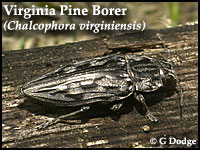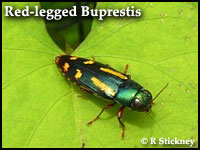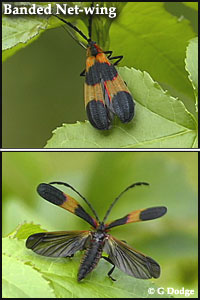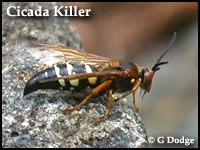I found a metallic woodboring beetle on the paved path in Explore the Wild. It was one of the large metallic woodborers, Chalcophora virginiensis (pictured at right). Its larvae bore into pines. One reference calls this beetle the Large Flat-headed Pine Heartwood Borer (the thoracic section of the larva or grub is flattened). I think it’s much easier to say Virginia Pine Borer, so that’s what I call it. Adult beetles have a bullet-shaped body, as do the other beetles in the family of metallic woodborers. Many of the metallic woodborers are striated and brightly colored, although this one is rather cryptic and roughly textured.
I briefly saw another slightly smaller but more brightly colored member of this family of beetles earlier in the first week of July, Buprestis rufipes. The only common name I could find for it (from several sources) was Red-legged Buprestis, which is pretty much the same as saying Buprestis rufipes (Buprestis with reddish feet/foot). I also found the same beetle referenced as Buprestis fasciata and Cypriacis fasciata. Taxonomy! Fasciata means banded but I didn’t see any bands on the beetle. I didn’t get a picture of it. Fortunately, one of the staff here at the Museum did (image below was taken by R. Stickney).
On the surface, Net-winged Beetles may be mistaken for moths with their textured forewings folded on their backs. I came upon a number of Banded Net-wings one calm morning in a shaded area of the Loop. These 1/2- to 3/4-inch beetles were apparently looking for mates as they flew from plant to plant, some of them indeed finding mates. Within an hour they had all dispersed.
Over the past few weeks I’ve seen many fresh Pearl Crescents and Eastern-tailed Blues; apparently a second brood of these small butterflies has emerged. I continue to see Silver-spotted Skippers and a few American Lady butterflies, although the latter have all been quite faded. I managed to catch a glimpse of a Cloudless Sulphur (only one) as it swiftly and erratically flew off to the northeast, never stopping to nectar.

Eastern Cicada Killers are large wasps. The males emerge in late June or early July. The first order of business after emerging is to stake out a territory and establish a regular perch from which to patrol that territory and wait for the females to arrive. One such male has staked a claim on the rocks outside the Lemur House. While intimidating for their large size and habit of flying out to investigate anything that wanders into their territory, including you, these male wasps can’t sting.
The females, which are larger than the males (about 2 inches), will emerge later, towards mid summer. They, the females, burrow into the ground to prepare a nest for their young. As their name implies, they hunt for Cicadas. The Cicada is stung, paralyzing it, and carried back to the burrow. As large as these wasps are, Cicadas are often a bit larger, so it’s quite a sight to see one of the wasps flying along with a Cicada “tucked in” below. Once in the burrow, an egg is laid on the Cicada, which will hatch a few days later. The larva will feed on the Cicada, prepare a cocoon for itself and overwinter underground, pupating and emerging as an adult the following year.



